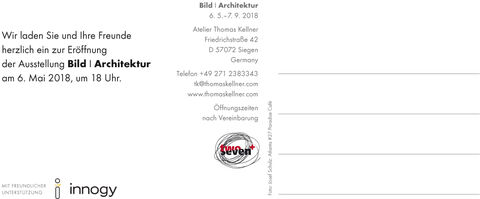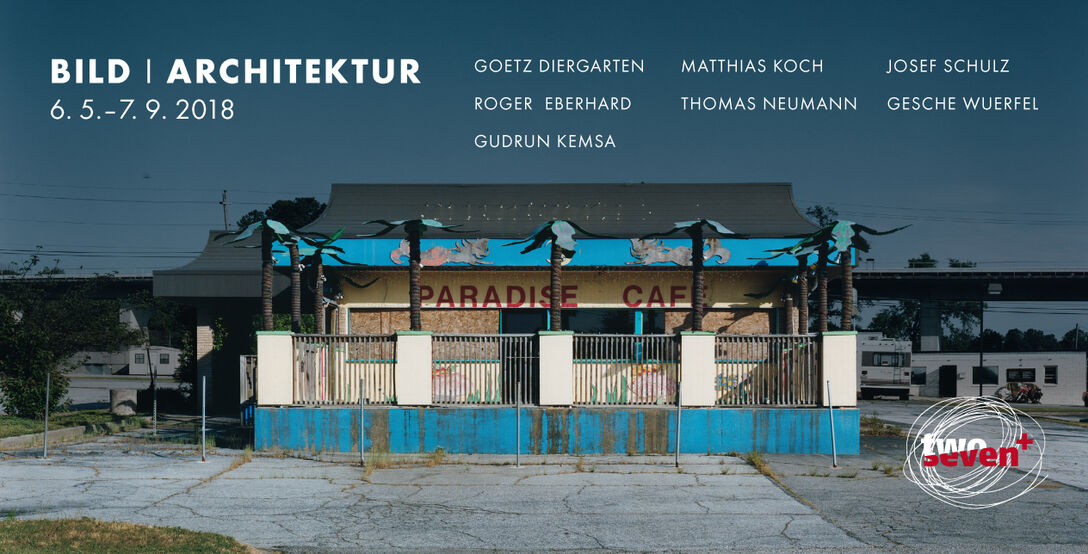
Image Architecture
May 6-September 7, 2018
Studio Thomas Kellner, Siegen, Germany
participating artists: Götz Diergarten, Roger Eberhard, Gudrun Kemsa, Matthias Koch, Thomas Neumann, Josef Schulz, Gesche Würfel

“Architecture is cult, is mark, symbol, sign, expression.
Architecture is control of body warmth – protecting habitation.
Architecture is determination – establishment of room, environment.
Architecture is conditioning of psychological state”
ALLES IST ARCHITEKTUR (1967)
«Bau» Schrift für Architektur und Städtebau, 23. Jahrgang, Heft 1/2, Wien 1968
Herausgegeben mit der Zentralvereinigung der Architekten Österreichs
Redaktion: Hans Hollein, Oswald Oberhuber, Gustav Peichl
auch in: «Alles ist Architektur - Eine Ausstellung zum Thema Tod»
27. Mai bis 5. Juli 1970, Städtisches Museum Mönchengladbach
For quite some time now, the term architecture is omnipresent. Its traditional meaning has fallen into oblivion. Broadly speaking, architecture describes the construction of buildings but the term was never linked to a precise definition. Architecture aims to differentiate itself from “mere building” in order to emphasize the difference between elevated art of construction and purposive construction. However, this classification falls short since architecture is always defined within the aesthetic, technical, economic and political context of its time.
Against this background, it is only natural that the meaning of a certain construction can change over the course of several years. Architecture can be considered a constant in time. In its inherent idea, it is unchangeable, even in the face of decay or expansion. Architecture always represents itself as physical expression of man in an attempt to shape the environment. As a result, contemporary circumstances define meaningfulness and purpose of a building.
Photography adds a new dimension to a building. The artist decides whether s/he wants to present the construction as relict of past days or lay the focus on the altered context in which it stands. In Fine Art Photography the meaning of architecture is extended, changed or dispossessed. The construction no longer stands for itself but evokes emotions and associations. Kochs work “Normandy – Atlantic Wall” elicits a flood of pictures of violence and terror within the beholder and recalls images of the department of the Allies on Normandy´s shoreline. Wuerfels works are equally emotionally challenging in depicting architecture as mark of human oppression. In Schulz´ pictures architecture turns into a symbolic relict of former cult. Eberhard “Shanty Town” transmits the promise of relaxation and comfort of a holiday of the extra class, despite its architectural imitation of Townships of troubled, predominantly black, classes in South Africa. The mineworker villages in Diergarten´s pictures have already served their time. Still, they remind us, as a relic, of the beloved home they once represented. Neumann´s work is proof that architecture performs authorial power and can shape a whole society. Man designs the environment through architecture and architecture affects man and shapes our reality. A stroll through New York City with Kemsa´s images illustrates that architecture define a city´s character and influences our idea of a certain place. The photos capture the aura of the constructions and are successful in transmitting it to their audience. The architecture´s emotional potential is activated through its photographic depiction. Architectural photography combines expression of the building with visual power.
Thank you to the participating arrtists for trusting to work with me on this show and thank you to the city of Siegen for the space to present this network.
Thank you to innogy for sending out the mail invitation for the show.









